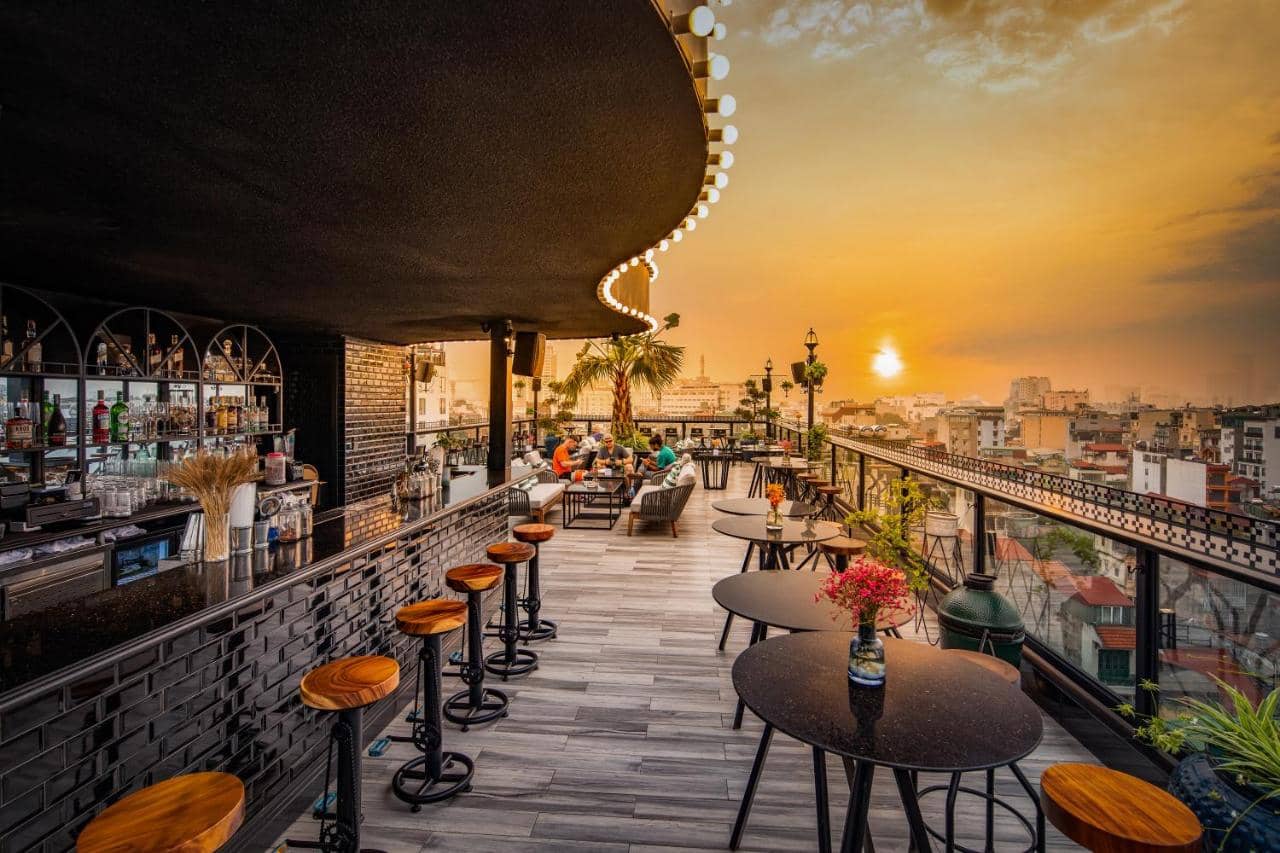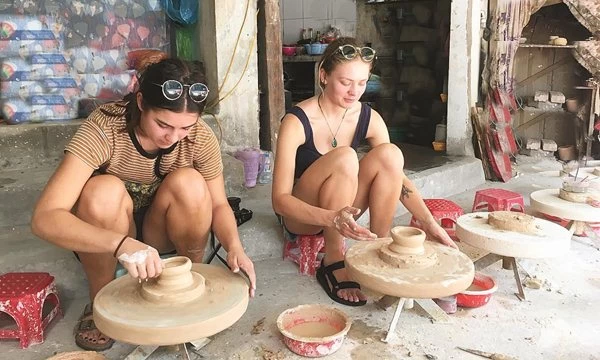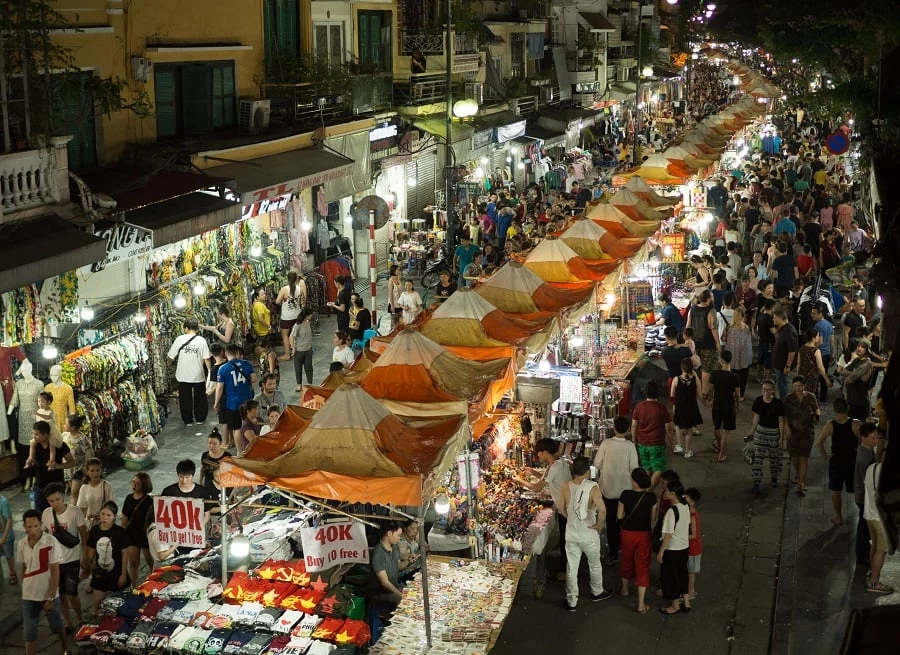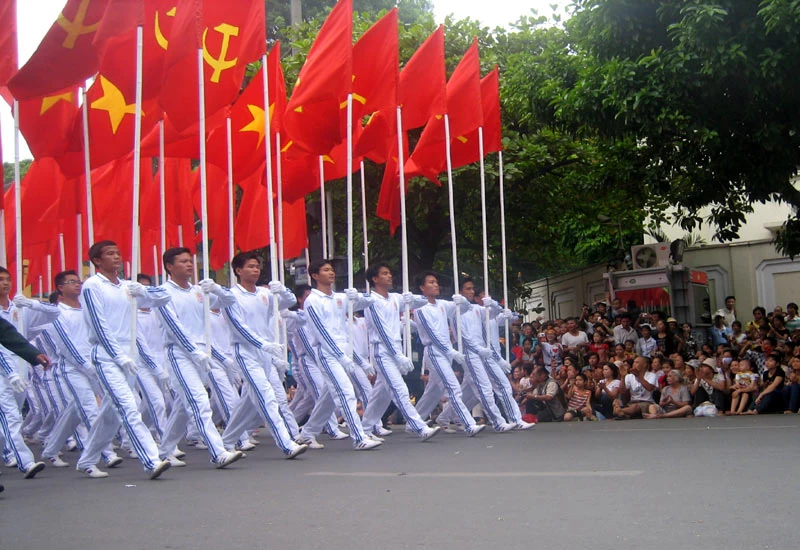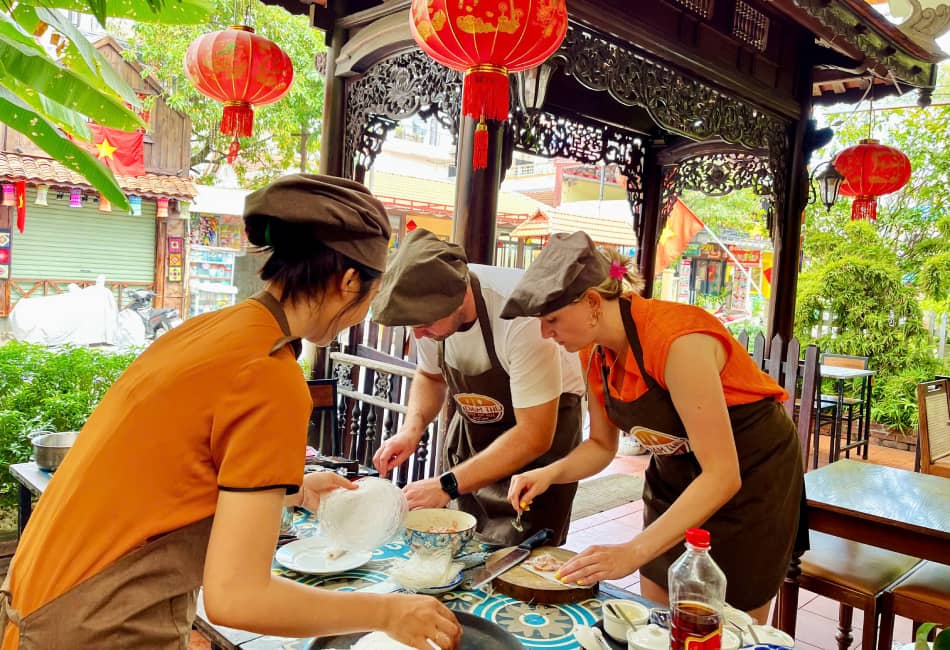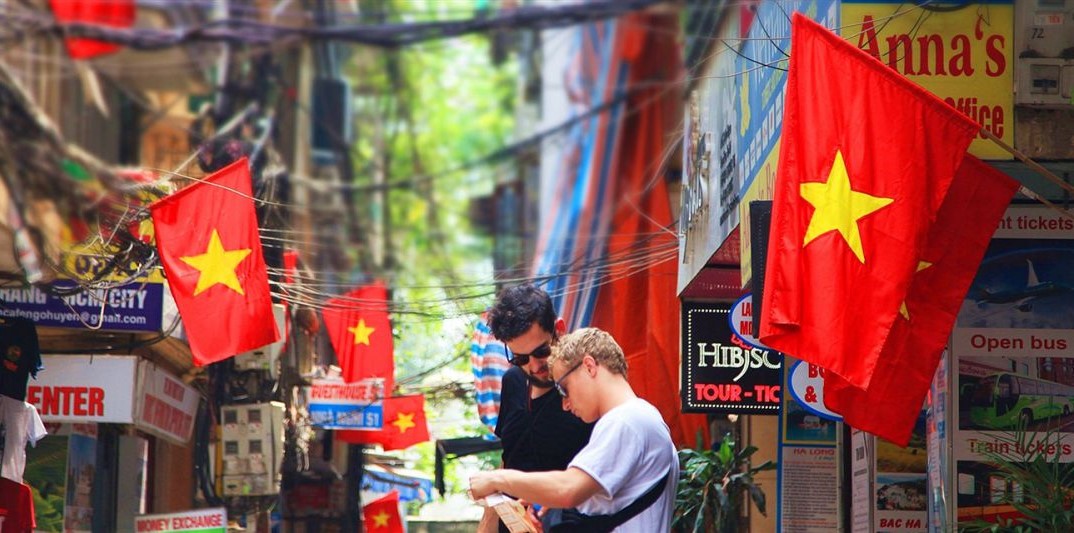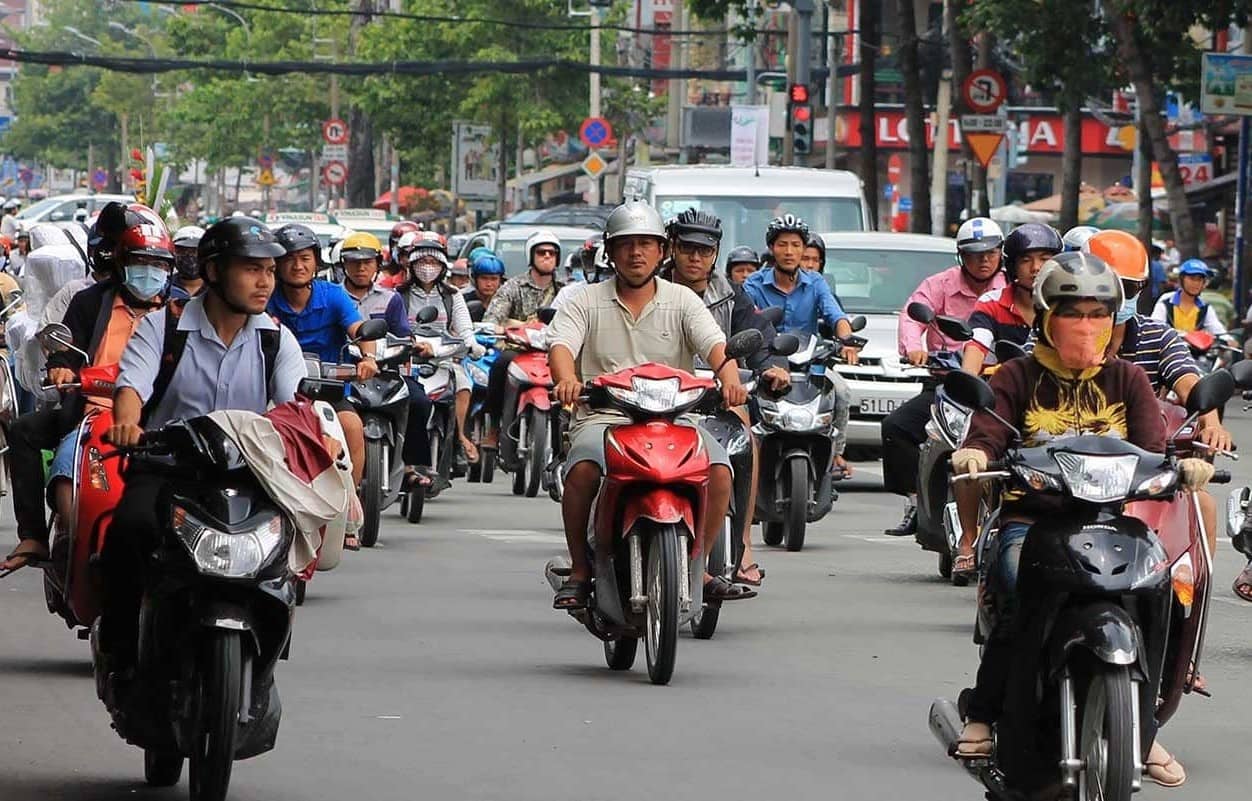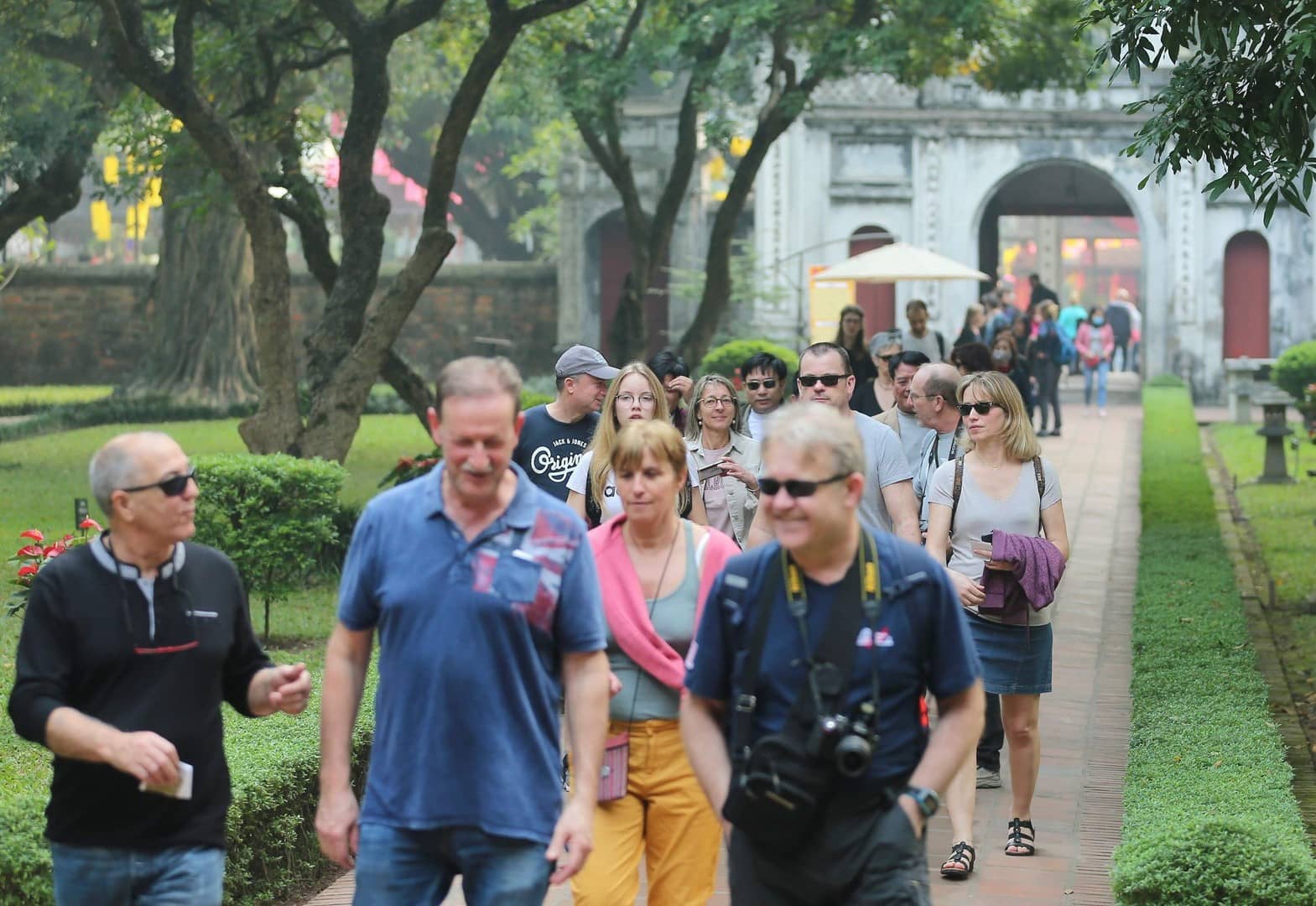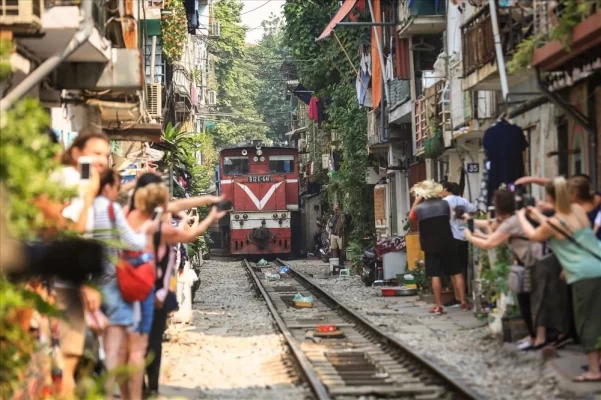
Train Street is a cultural feature only found in Hanoi
Explore the charm of Hanoi Train Street, a hidden gem and the best thing to do in Hanoi for international tourists. Discover its history, best times to visit, unique experiences, safety tips, and local culture. Perfect for photography enthusiasts and cultural explorers alike. Plan your visit with Ula Travel’s comprehensive guide!
I. Why Hanoi Train Street is a Must-See
1. Unique Urban Experience
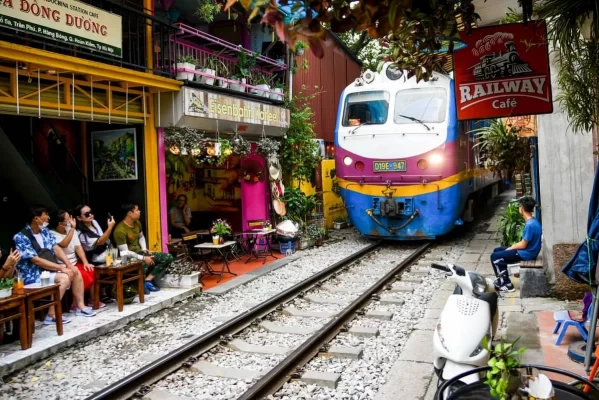
Nowhere gives you a feeling of both adventure and excitement like Hanoi Train Street
Unlike any other place in the world, Hanoi Train Street offers a one-of-a-kind experience where visitors can witness the extraordinary coexistence of urban life and railway operations. The sight of a train rumbling through such a tight space, with residents and visitors standing mere feet away, is both thrilling and surreal.
Click here: Hanoi Day Trip
2. Memory Photos
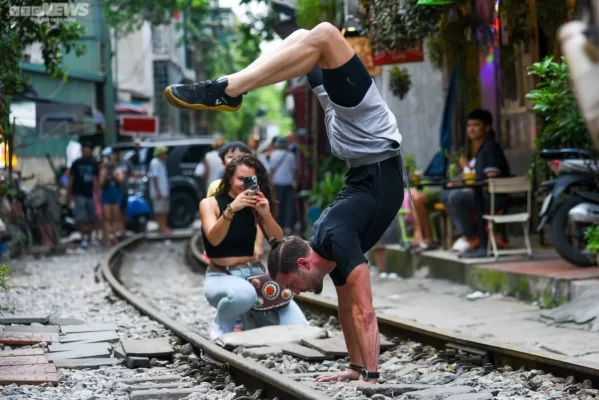
You will have great commemorative photos with the beauty of the street
For photography enthusiasts, Hanoi Train Street is a gold mine. The juxtaposition of the modern train against the backdrop of traditional Vietnamese houses, coupled with the vibrant street life, creates perfect photo opportunities. The street’s aesthetic appeal is heightened by the colorful murals, quaint cafes, and bustling activity that surround it.
3. Cultural Insight
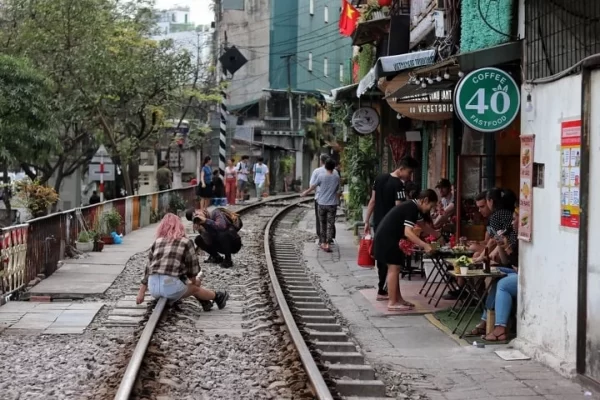
People’s daily life still takes place on this special street
Visiting Hanoi Train Street provides a deep dive into the daily lives of Hanoi’s residents. It’s a chance to observe how local people have seamlessly integrated the train schedule into their routines, moving their activities and possessions out of the way as the train approaches and resuming their day-to-day lives immediately after it passes.
4. Local Interaction
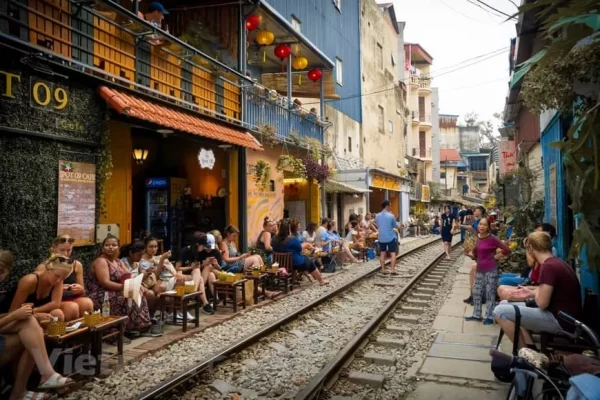
Visitors can comfortably drink coffee and chat with friendly locals
The street is lined with small cafes and shops where visitors can interact with locals, savor traditional Vietnamese coffee, and enjoy the laid-back yet vibrant atmosphere. These interactions offer a glimpse into the warmth and hospitality of the Vietnamese people, making the visit even more memorable.
II. The History and Importance of Hanoi Train Street
1. History of Hanoi Train Street
Hanoi Train Street, officially known as the section of the railway line that passes through residential neighborhoods between Le Duan and Kham Thien streets, dates back to the early 1900s.
This railway line was constructed during the French colonial period as part of a broader network designed to connect Hanoi with the rest of Vietnam and beyond. The railway served as a crucial transportation link, facilitating the movement of goods and people across the region.
Over the decades, as Hanoi expanded and developed, residential areas began to encroach upon the railway line. Families built their homes and businesses close to the tracks, creating the unique that we see today. Despite the proximity to the railway, the residents have adapted to the daily passage of trains, integrating this unusual aspect into their daily lives.
2. Importance of the Railway in Daily Life
For the residents living along Hanoi Train Street, the railway is more than just a mode of transportation; it is an integral part of their daily existence.
The train schedules dictate the rhythm of life here, with local vendors and families well-versed in the timings of the trains, allowing them to seamlessly transition between daily activities and make way for the passing locomotives.
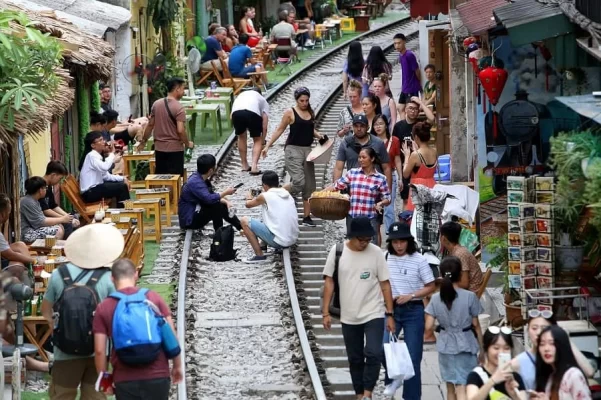
Hanoi Train Street has become a part of people’s lives
The railway serves as a lifeline, connecting these neighborhoods to the rest of Hanoi and beyond. The sight of a train passing through this narrow street, with locals calmly going about their business, is a testament to the resilience and adaptability of the Hanoian people.
Hanoi Train Street has also become a symbol of the blending of tradition and modernity. It highlights how urban development and historical infrastructure can coexist, offering a unique perspective on the city’s evolution.
For visitors, it is an opportunity to witness firsthand the dynamic interplay between Hanoi’s rich cultural heritage and its ongoing growth and transformation.
III. Location and How to Get There
1. Location of Hanoi Train Street
Hanoi Train Street, a popular tourist attraction, is situated in the Hanoi Old Quarter. The exact address for the most visited part of the street is between Le Duan and Kham Thien Street, particularly on the track section running through Tran Phu Street. To be more precise, the busiest part where tourists flock is along the narrow street at 224 Le Duan, Hoan Kiem District, Hanoi.
2. Transportation Methods from Hanoi City Center
Getting to Hanoi Train Street from the city center is quite straightforward. Here are some common transportation options:
- Walking: If you’re staying in the Old Quarter, you can enjoy a leisurely walk to Hanoi Train Street. It takes around 20–30 minutes, depending on your starting point. This is a great way to explore the bustling streets of Hanoi and soak in the local atmosphere.
- Cyclo: A traditional Vietnamese cyclo ride is a unique and relaxing way to get to the train station. You can negotiate a price with the cyclo driver; it usually costs around 100,000 VND ($4-5 USD) for a short ride.
- Taxi or Ride-Hailing Apps: Taxis are widely available in Hanoi. You can also use ride-hailing apps like Grab or Be. The fare from the Hoan Kiem Lake area to Hanoi Train Street typically ranges from 50,000 VND to 100,000 VND ($2–5 USD), depending on traffic.
- Motorbike or scooter: Renting a motorbike or scooter is another option for getting around Hanoi. Daily rental rates are about 150,000 VND ($6-7 USD). Make sure to have an international driver’s license and be prepared for the chaotic traffic.
IV. Best Time to Visit Hanoi Train Street
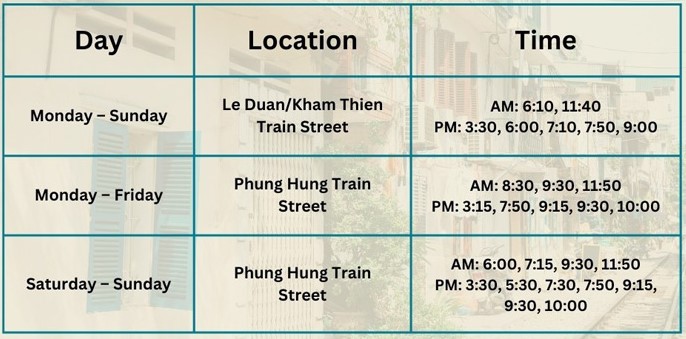
Hanoi Train Schedules
Optimal Time of Day to Visit (Train Schedules)
Hanoi Train Street offers a unique experience of watching trains pass just inches away from the buildings. To witness this spectacle, it’s essential to know the train schedules. The trains typically run at the following times:
- Morning: Around 7:00 a.m.–7:30 a.m.
- Afternoon: Around 3:30 PM–4:00 PM
- Evening: Around 7:00 p.m.–7:30 p.m.
- Night: Around 11:00 p.m.–11:30 p.m.
Visiting during these times allows you to experience the thrill of the train passing through the narrow street, creating an unforgettable experience. Arrive at least 30 minutes before the scheduled train time to find a good spot and soak in the local atmosphere.
V. Unique Experiences at Hanoi Train Street
1. Perched only a few centimeters from the passing train
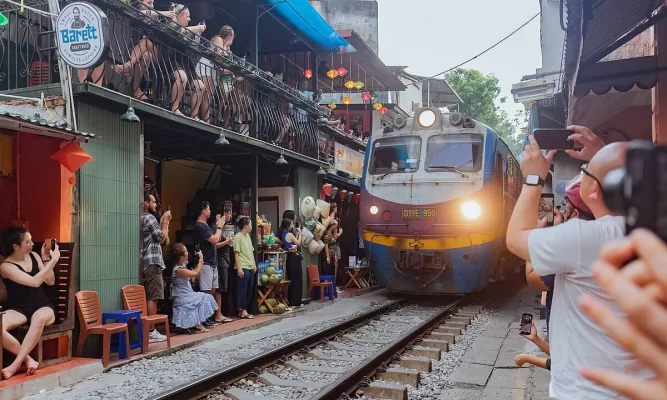
The train is just a few centimeters away from you.
One of the most thrilling aspects of visiting Hanoi Train Street is the unique experience of sitting just a few feet away from the train tracks as the train rushes by.
This close encounter offers an exhilarating mix of excitement and slight trepidation, as you can feel the ground vibrate and hear the whistle of the approaching train getting louder with each second. The narrow alleyways come alive with a sense of anticipation, and for a moment, the bustling city life pauses as everyone waits for the train.
As the train nears, local residents and visitors alike gather their belongings and move closer to the walls of the buildings lining the tracks. Within moments, the train appears, and the narrow street is filled with the sight and sound of the passing locomotive. The experience is both thrilling and surreal, offering a rare chance to witness an everyday occurrence that has become an iconic symbol of Hanoi.
2. Experience Vietnam’s Coffee Culture at Hanoi Train Street
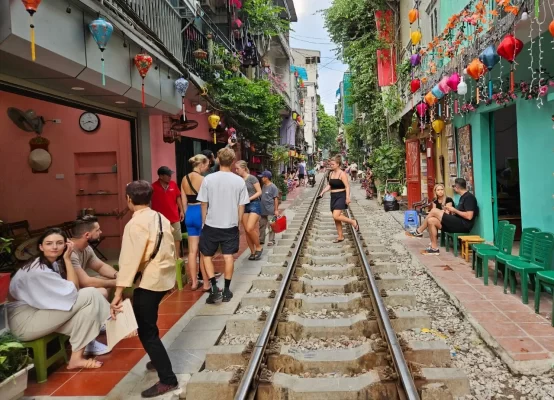
You will fall in love with Vietnam’s cafe culture
Visiting Hanoi Train Street offers more than just a glimpse of passing trains; it’s a gateway to Vietnam’s vibrant coffee culture. Nestled amidst the quaint lanes are charming cafés where visitors can savor traditional Vietnamese coffee varieties like drip coffee and egg coffee.
The ambiance, often bustling yet serene, provides a unique backdrop for cultural immersion. Engage with locals over a cup, gaining insights into the rituals and significance of coffee in Vietnamese daily life. This experience not only tantalizes the taste buds but also captures the essence of Hanoi’s dynamic blend of tradition and modernity.
Read more: Best Coffee Shops in Hanoi That You Must Try ASAP
3. A Vibrant Atmosphere
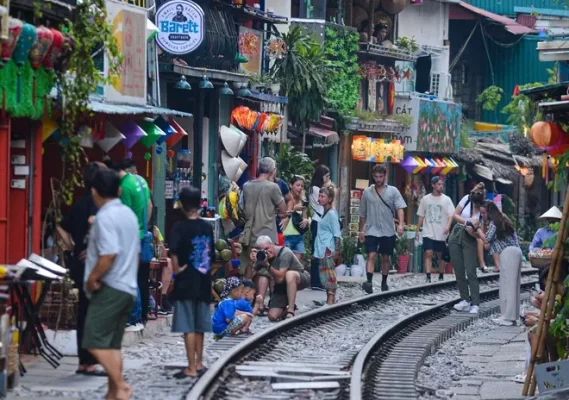
The street is always bustling and has a very unique cultural color
The atmosphere at Hanoi Train Street is nothing short of vibrant and exhilarating. As you walk along the narrow tracks, you’ll be immersed in a bustling scene filled with the lively chatter of locals and tourists alike.
The air is filled with the enticing aromas of street food being prepared by vendors, offering a tantalizing array of flavors from savory bánh mì to sweet desserts. The colorful facades of the houses, adorned with plants and traditional Vietnamese decorations, add to the visual feast. As the train approaches, there’s a palpable sense of excitement and anticipation.
Locals expertly maneuver their daily routines around the train schedule, quickly pulling in their tables and merchandise just moments before the train rumbles past, mere inches away. This thrilling spectacle, combined with the surrounding energy, creates an unforgettable experience that captures the dynamic spirit of Hanoi.
4. Perfect Photo Opportunities
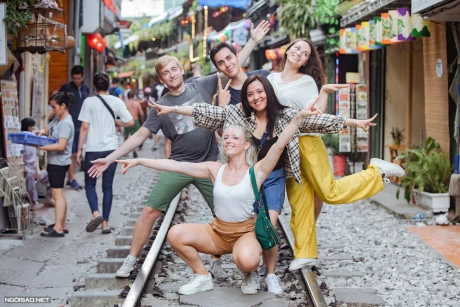
Any visitor to Hanoi Train Street wants to have souvenir photos
Hanoi Train Street is a photographer’s paradise, offering countless opportunities to capture stunning and unique shots. The narrow railway track, flanked by colorful houses and bustling street life, provides a picturesque and dynamic backdrop.
As the train approaches, the excitement builds, making it the perfect moment to capture the essence of the street’s vibrant atmosphere.
Early mornings and late afternoons offer the best natural light, casting a warm glow on the scene and highlighting the intricate details of the surroundings. The contrast between the modern train and the traditional Vietnamese setting creates a compelling visual narrative.
Additionally, candid shots of locals going about their daily routines, vendors preparing street food, and tourists eagerly awaiting the train all add to the rich tapestry of life at Hanoi Train Street. Whether you’re an amateur with a smartphone or a professional with a high-end camera, this location promises a plethora of captivating and memorable photo opportunities.
VI. Local Culture at Hanoi Train Street
1. How Locals Live and Work Around the Tracks
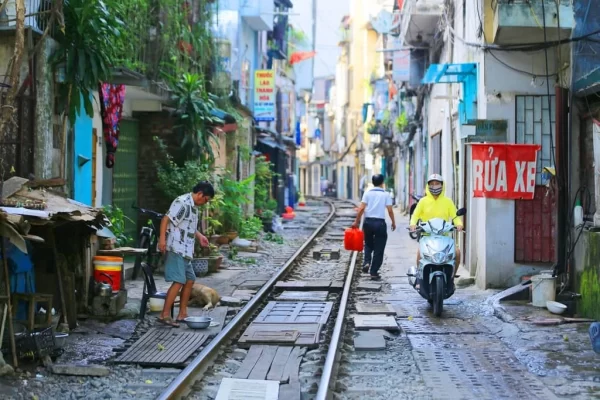
People’s daily activities when there is no train passing by.
Hanoi Train Street is more than just a picturesque attraction; it is an integral part of the daily lives of the local residents. The narrow alleyways flanked by the railway tracks are home to many families who have lived there for generations.
These residents have adapted to the routine of trains passing mere inches from their doorsteps, creating a unique blend of urban living and railway culture.
Every day, locals carry out their routines just inches from the railway tracks. You can observe vendors selling fresh produce, families having meals, and children playing.
Laundry is often hung on lines strung across the alley, and small businesses operate right on the edge of the tracks. This seamless integration of daily life with the railway operations is a testament to the adaptability and resilience of the community.
2. Opportunities for Cultural Exchange
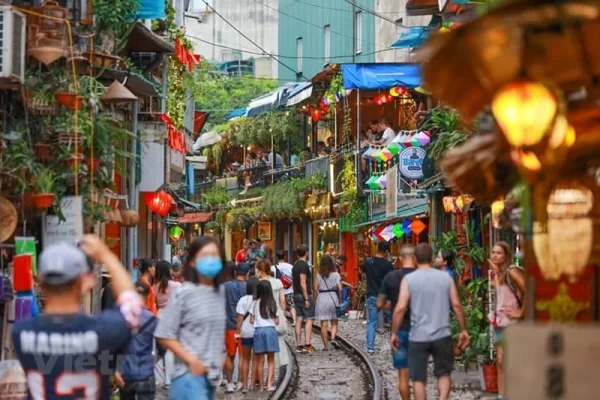
Come and experience the special culture at Hanoi Train Street
Visiting Hanoi Train Street offers a unique opportunity for cultural exchange and interaction with the locals. The residents are often friendly and open to engaging with tourists, offering a glimpse into their way of life. Here are a few ways you can immerse yourself in the local culture:
- Chat with Locals: Many residents are willing to share stories about their lives and the history of the neighborhood. A simple greeting or a smile can lead to a meaningful conversation, especially if you show genuine interest and respect.
- Experience Local Cuisine: Along the tracks, you’ll find several small eateries and street vendors offering traditional Vietnamese dishes. Trying local food is not only a delight for your taste buds but also a way to connect with the culture. Popular dishes include pho, banh mi, and various street snacks.
- Participate in Daily Activities: Observing or even participating in daily activities can enrich your understanding of the local way of life. Whether it’s helping a vendor set up their stall or learning how to prepare a local dish, these experiences are invaluable.
- Respect the Space: Remember that while Hanoi Train Street is a popular tourist destination, it is also a residential area. Respect the privacy and space of the residents. Avoid intrusive behavior, and always ask for permission before taking photographs of people or their homes.
VII. Safety Tips for Visiting Hanoi Train Street
When visiting Hanoi Train Street, safety should be your top priority. The proximity of the railway to residential and commercial areas makes it a unique but potentially hazardous attraction. Here are some essential safety tips to ensure a safe and enjoyable experience:
1. Keep a safe distance from the tracks.
- Maintain a Safe Distance: Always keep a safe distance from the railway tracks. Avoid standing or sitting too close to the tracks to prevent accidents.
- Respect the Barriers: Some areas may have barriers or signs indicating the safe zones. Ensure you stay within these marked areas.
2. Be aware of train schedules.
- Know the Train Timings: Trains pass through Hanoi Train Street multiple times a day. Check the train schedule in advance and plan your visit accordingly.
- Listen for the Train Horn: Trains typically sound their horns when approaching. Stay alert and move away from the tracks as soon as you hear the horn.
3. Follow local advice.
- Heed Local Warnings: The locals are well-versed in the train timings and the safest spots to stand. Listen to their advice and follow any warnings they give.
- Observe Others: Pay attention to where the locals and other visitors stand when a train is approaching. This can give you a good idea of the safest areas.
4. Avoid distracted behavior.
- Stay Focused: Avoid using headphones or engaging in activities that might distract you from noticing an approaching train.
- No Risky Photography: While capturing the perfect photo is tempting, do not risk your safety for a picture. Ensure you have ample time to move away from the tracks.
5. Supervise children and pets.
- Keep an Eye on Kids: If you’re visiting with children, ensure they are always supervised and understand the importance of staying away from the tracks.
- Control Your Pets: If you bring pets, keep them on a leash and ensure they stay a
In conclusion, Hanoi Train Street embodies the charm and vibrancy of Vietnam’s capital city, offering a unique experience that blends cultural immersion with awe-inspiring moments as trains pass through narrow residential alleys. Visitors are captivated not only by the sight of trains traversing through bustling neighborhoods but also by the warmth of local hospitality and the opportunity to witness daily life up close.
Whether you’re a photographer seeking the perfect shot or a traveler eager to explore off-the-beaten-path attractions, Hanoi Train Street promises a memorable and authentic adventure that showcases the soul of Hanoi.
See more: Hanoi Travel Tips



